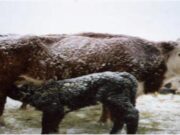
Introduction
Current environmental controlled conditions for animals are primarily found in industry and government publications.Many of the current intensive livestock production systems require the provision of a controlled environment for housed stock. Pigs, poultry and animals are the most often associated with controlled environments in commercial agriculture; however, there are other animals that can also thrive in controlled conditions at some time during their lives.Most farmers would think an animal’s ‘environment’ involves little more than temperature and humidity, but it goes much farther than that. ‘Environment’ embraces other factors like air speed, air quality, light level and colour and surrounding surface materials. Well-designed systems will maximise outputs by increasing growth and lowering mortality, while reducing inputs, particularly feed and energy, and improving stock health and welfare. Some of the essential principles involved are covered in this article.
Critical environmental issues for different species
| Species | Temperature | Humidity | Light | Air speed |
| Pig | Growth and food intake highly dependent on temperature (piglets and weaners, in particular) | Extremes of humidity to be avoided. Optimum conditions 60–90% relative humidity | Various requirements with regard to reproductive success and feed intake | Critical chill factor and dunging habit and potential vice issues |
| Adult animals | Tolerant to a wide range of UK conditions, so controlled temperature only required in more extreme conditions | High relative humidity is detrimental and can be partially mitigated by high air exchange rates | Milk output, feed intake and growth rates for beef cattle | Not critical |
| Young animals | Thrive best in moderate conditions when animals are very young | Pneumonia is a potential problem with calves, so high air change rates are required | Not critical | Air speed should be limited |
| Sheep | Tolerant to the full range of UK conditions, so no need for controlled temperature; lambs can benefit from heat in marginal conditions | Not critical | Not critical | Not critical |
Temperature
There is a temperature at which any species or breed of animal confined under a specific set of conditions will begin to divert more energy from growth to maintaining its own body temperature. The lower critical temperature is referred to as this (LCT). In addition, there is a temperature over which the animal will use additional energy to stay cool (Eg. by panting). The upper critical temperature is known too as this (UCT). The thermoneutral zone exists between the LCT and the UCT, and it is here that body ‘maintenance’ factors are minimised, allowing maximum use of food for production. The farmer can obtain the most cost-effective operation and highest margin by fine-tuning within the thermoneutral zone.
The animal’s ability to maintain this body temperature is achieved by thermoregulatory mechanisms. For instance, to lose heat an animal can pant, sweat, the coat can be flattened and the blood vessels dilated. Conversely, to maintain heat there will be an absence of panting, sweating, an erect coat and vasoconstriction. Additionally, at low temperatures an increase in metabolic rate will be needed to provide increased energy to maintain body temperature. The increase in energy usage at the upper end of the environmental temperature scale. It is necessary to provide the animal with a ‘tighter’, more controlled environment for good performance.
Housed cattle can be more susceptible to heat stress than animals kept outside because they simply get hotter. The exception is with grazing cattle, which do not have access to shade in the hottest conditions. Young ruminant stock is more susceptible to extreme conditions. Low temperatures alone are rarely a great problem for the young healthy animal because it can benefit from the heat and shelter provided by the body of its mother, but the effect of high air speed in cold conditions can cause problems. Reference to the wind chill factors in the relationship between temperature and air speed on body heat losses. In buildings for young stock, design of air flow must therefore avoid draughts at animal level. In cases where an animal has been orphaned, intentionally separated from the mother shortly after birth (removing the possibility of maternal warmth) or is sick, provision of additional shelter and supplementary heat can be necessary.
Air speed
LCT and UCT values are notably affected by draughts (for the purposes of this article, for calvesa draught is defined as air moving faster than 0.5m/s). Other species may be more or less tolerant. A well-designed ventilation system subjects the livestock to low air speed in winter to avoid chilling and higher air speed in summer to produce greater evaporative cooling and so raise the UCT. These features are most important and are best achieved with fan ventilation systems. Below table shows how the LCT for pigs goes up as air speed increases and emphasises the importance of avoiding draughts in cold conditions.
| Air speed (metres per second) | 0.25 | 0.73 |
| Mean temp (°C) | 21 | 21 |
| Max temp (°C) | 33 | 33 |
| Feed gain ratio | 3.48 | 3.15 |
Light
Knowledge of the effects of light levels, periods and spectrum is increasing all the time. Recent work has suggested that adjusted daily lighting periods can improve performance in pigs, calves and dairy cows in terms of growth and reproductive performance. Providing sufficient light and appropriate day lengths has also become a welfare issue and now these two factors are set out in welfare standards. One aspect receiving more attention recently is lighting spectrum. In the past, manipulation of the light spectrum has rarely been considered because the technology to put this into practice has not been economically viable. The introduction of LED (light-emitted diode) lighting has changed all this.
Animal responses to aspects of artificial lighting are an important factor in designing a lighting scheme. Using an inappropriate artificial light could result in the illuminance (lux) being too high or too low, or an unsuitable spectral output for the livestock. The consequences of inappropriate lighting may affect the health, production and welfare of your stock because of light-induced biological responses. The key characteristics to consider are:
- Spectral composition – the distribution of light wavelengths (how much of each colour is present)
- Illuminance – the total amount of luminous power produced in the visual part of the light spectrum, measured in lux (based upon the livestock you are considering)
- The number of hours of light and dark (or photoperiod) in a 24-hour period
- Rate of change of lighting level (dawn/dusk simulation)
These are some lighting sources In candescent, Fluorescent, Light-emitting diode, Gas discharge used in house to maintain lights.
Ventilation
Primary purposes of air ventilation systems for non-ruminant livestock houses should be able to satisfy the following major objectives:
- Temperature control – In temperate conditions, provide variable air throughput to control the house temperature to a prescribed level.
- Temperature limitation – In summer conditions, provide adequate air throughput to limit the building temperature to between 3°C and 4°C above the outside temperature.
- Increase upper critical temperature – In very hot conditions, provide high air speeds over the stock to increase animals’ upper threshold of temperature tolerance (UCT).
- Limit air pollutants and build-up of high humidity – In cold conditions, provide enough ventilation to suppress the build-up of polluted, stale or humid air, while maintaining desirable air flow without draughts on the animals and at a rate that minimises the use of heat.
In most mechanical ventilation systems used for livestock applications, the most common component is the propeller fan. These fans are characterised by a ‘paddle’ impeller, which can move large amounts of air at relatively low back pressures. Propeller fans are comparatively cheap, easy to install and reliable. Rather than the paddle blade, some modern types of propeller fan use an impeller with an aerofoil cross-section and are capable of operating at higher pressures.
Heating
Supplementary heating is used to maintain temperature when there is a deficit of heat in a building or an area of a building. If this happens, the temperature may fall below the lower critical temperature of the animals and feed energy will be diverted from growth to maintenance. In extremes, especially for younger stock, low temperatures will have an effect on mortality rates. In British climatic conditions, heating is normally only considered for young, non-ruminant stock. With older non-ruminants, the use of carefully controlled minimum ventilation rates and insulation in adequately stocked buildings will ensure that recommended temperatures are achieved. Occasionally, in very cold conditions, heating may be used to advantage with young ruminant or sick animals. Bright emitter infrared lamp, Notable features, Ceramic dull emitter infrared heater, Panel heaters, Metal-sheathed dull emitter heater, Gas plaque and mesh radiant heaters, Gas-fired tubular heaters etc. are mostly used in livestock.

Dr.Sachin Dongare (Ph.D. Scholar)
Department of Livestock Production Management
Govind Ballabh Pant University of Agriculture and Technology, Pantnagar
Corresponding Author Email id- sachindongare12345@gmail.com




















Comments are closed.